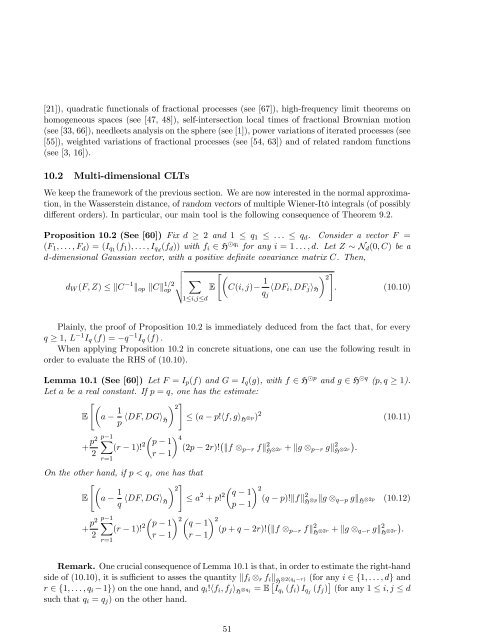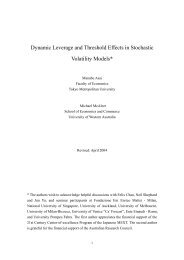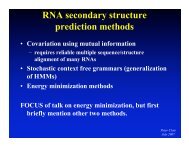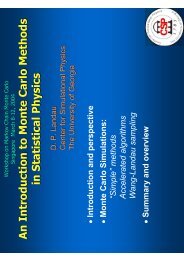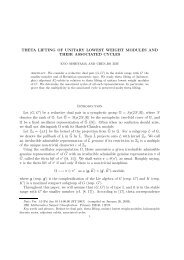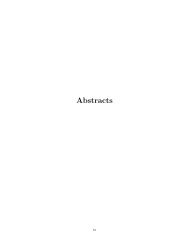Stein's method, Malliavin calculus and infinite-dimensional Gaussian
Stein's method, Malliavin calculus and infinite-dimensional Gaussian
Stein's method, Malliavin calculus and infinite-dimensional Gaussian
Create successful ePaper yourself
Turn your PDF publications into a flip-book with our unique Google optimized e-Paper software.
[21]), quadratic functionals of fractional processes (see [67]), high-frequency limit theorems on<br />
homogeneous spaces (see [47, 48]), self-intersection local times of fractional Brownian motion<br />
(see [33, 66]), needleets analysis on the sphere (see [1]), power variations of iterated processes (see<br />
[55]), weighted variations of fractional processes (see [54, 63]) <strong>and</strong> of related r<strong>and</strong>om functions<br />
(see [3, 16]).<br />
10.2 Multi-<strong>dimensional</strong> CLTs<br />
We keep the framework of the previous section. We are now interested in the normal approximation,<br />
in the Wasserstein distance, of r<strong>and</strong>om vectors of multiple Wiener-Itô integrals (of possibly<br />
di¤erent orders). In particular, our main tool is the following consequence of Theorem 9.2.<br />
Proposition 10.2 (See [60]) Fix d 2 <strong>and</strong> 1 q 1 : : : q d . Consider a vector F =<br />
(F 1 ; : : : ; F d ) = (I q1 (f 1 ); : : : ; I qd (f d )) with f i 2 H q i<br />
for any i = 1 : : : ; d. Let Z N d (0; C) be a<br />
d-<strong>dimensional</strong> <strong>Gaussian</strong> vector, with a positive de…nite covariance matrix C. Then,<br />
v<br />
d W (F; Z) kC 1 k op kCk 1=2 u<br />
t X<br />
op<br />
1i;jd<br />
E<br />
" <br />
C(i; j)<br />
#<br />
1<br />
2<br />
hDF i ; DF j i H : (10.10)<br />
q j<br />
Plainly, the proof of Proposition 10.2 is immediately deduced from the fact that, for every<br />
q 1, L 1 I q (f) = q 1 I q (f) :<br />
When applying Proposition 10.2 in concrete situations, one can use the following result in<br />
order to evaluate the RHS of (10.10).<br />
Lemma 10.1 (See [60]) Let F = I p (f) <strong>and</strong> G = I q (g), with f 2 H p <strong>and</strong> g 2 H q (p; q 1).<br />
Let a be a real constant. If p = q, one has the estimate:<br />
" #<br />
1<br />
2<br />
E a<br />
p hDF; DGi H<br />
(a p!hf; gi H p) 2 (10.11)<br />
+ p2<br />
2<br />
Xp 1 p 1 4<br />
(r 1)! 2 (2p 2r)! kf p r fk 2 H<br />
+ kg <br />
r 1<br />
2r p r gk 2 <br />
H : 2r<br />
r=1<br />
On the other h<strong>and</strong>, if p < q, one has that<br />
" #<br />
1<br />
2 q 1 2<br />
E a<br />
q hDF; DGi H<br />
a 2 + p! 2 (q p)!kfk 2 H<br />
kg <br />
p 1<br />
p q p gk H 2p (10.12)<br />
+ p2 Xp 1 p 1 2 q 1 2<br />
(r 1)! 2 (p + q 2r)! kf p r fk 2 H<br />
+ kg <br />
2<br />
r 1 r 1<br />
2r q r gk 2 <br />
H : 2r<br />
r=1<br />
Remark. One crucial consequence of Lemma 10.1 is that, in order to estimate the right-h<strong>and</strong><br />
side of (10.10), it is su¢ cient to asses the quantity kf i r f i k H 2(q i r) (for any i 2 f1; : : : ; dg <strong>and</strong><br />
r 2 f1; : : : ; q i 1g) on the one h<strong>and</strong>, <strong>and</strong> q i !hf i ; f j i H q i = E I qi (f i ) I qj (f j ) (for any 1 i; j d<br />
such that q i = q j ) on the other h<strong>and</strong>.<br />
51


